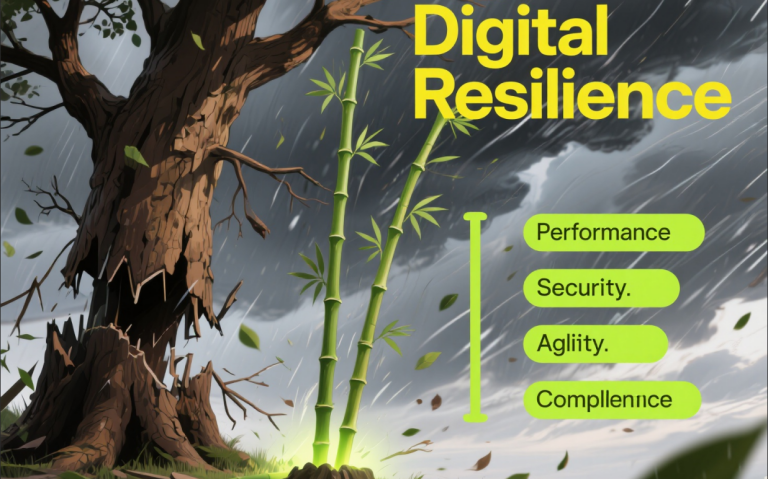
99.9%. 99.99%. 99.999%.
In the world of digital infrastructure, this has been our holy grail. The number of nines in our uptime percentage became a badge of honor, a testament to our engineering prowess. We built powerful, robust systems designed to be fortresses—rigid, strong, and unwavering. We measured our success by a simple, binary metric: Is it up, or is it down?
But what if I told you that this obsession with uptime is a dangerous illusion? What if that string of nines, which looks so comforting on a status page, tells you absolutely nothing about your business’s ability to survive a real crisis?
An ancient oak tree can stand tall and proud for a hundred years of perfect weather, boasting a near-100% "uptime." But on the day the hurricane finally makes landfall, its very rigidity becomes its fatal flaw. The unbending trunk snaps, and the entire structure comes crashing down. A slender bamboo, however, is designed differently. It bends, it sways, it yields to the force of the storm, and when the wind passes, it stands tall once more.
The internet of 2026 is a hurricane. It is a chaotic, unpredictable, and often hostile environment. The “shocks” to your system are no longer rare, black swan events; they are the new normal. They are the sophisticated zero-day attacks, the sudden hundred-fold traffic spikes from a viral TikTok video, the catastrophic regional outages of a major cloud provider, the sudden implementation of a new data privacy law that renders your architecture illegal overnight.
In this new reality, the critical question is no longer, “What is your uptime?” The new, more meaningful question is, “What is your recovery time?”
This is the shift from measuring simple availability to cultivating true Digital Resilience. It’s a move away from building rigid fortresses and towards engineering flexible, adaptive ecosystems. It's about designing a system that doesn't just aim to never fall down, but is built with the assumption that it will get hit, and has the intelligence and agility to get back up, stronger than before. This is your guide to moving beyond the fragile pursuit of nines and into the art of building an unbreakable digital business.
Chapter 1: The Shifting Ground - A New Landscape of Risk
Why has our old definition of success—rock-solid uptime—become so inadequate? Because the ground beneath our digital fortresses is no longer stable. The very nature of risk has changed. The “earthquakes” are now more frequent, more complex, and coming from directions we never anticipated.
The New Tremors Shaking Every Business:
Hyper-Sophisticated, Asymmetric Threats: The security landscape is no longer about blocking clumsy script kiddies. We are fighting organized, well-funded adversaries who leverage AI to craft perfect spear-phishing emails, who bypass our firewalls with clever application-layer attacks like Slowloris, and who poison our software from the inside out through sophisticated supply chain attacks. A simple wall is no defense against an enemy who can tunnel underneath it or teleport inside.
The Fragility of Centralization: We moved our infrastructure to a few, massive public clouds, believing them to be infallible. But a single, massive outage in an AWS or Azure region can now take out a significant portion of the internet, including your business if you’ve placed all your eggs in that one basket. The cloud is powerful, but it is not invincible.
The Unpredictability of Demand: In the age of social media and viral trends, your traffic is no longer a predictable bell curve. A single tweet from an influencer or a mention on a popular news site can unleash a torrent of traffic that looks and feels exactly like a massive DDoS attack. An architecture designed for predictable scale can be overwhelmed in seconds by unpredictable popularity.
The Regulatory Minefield: The world is no longer a single, borderless market. A patchwork of data sovereignty laws like GDPR in Europe, CCPA in California, and PIPL in China now govern where and how you can handle user data. A new regulation can be passed that requires you to fundamentally re-architect your global data strategy overnight, or face crippling fines.
In this environment, a rigid system, no matter how “up,” is a fragile system. Resilience is the new imperative.
Chapter 2: The Blueprint for Resilience - The Four Core Pillars
True digital resilience isn’t a single product you can buy. It’s an architectural philosophy. It’s a state of being. It is built upon four interconnected pillars that transform your business from a rigid oak into a flexible bamboo.
Pillar 1: Performance at Scale (The Flexible Superstructure)
This is the most obvious pillar, but its definition must be expanded. It's not just about being fast; it's about being gracefully elastic.
The Old Way: Provision a massive server that can handle your predicted peak traffic. This is expensive and inefficient.
The Resilient Way: Build a system that can absorb and adapt to unpredictable stress.
The Global CDN Layer: This is the primary shock absorber. A CDN with a massive global capacity is the only way to handle a sudden, legitimate 100x traffic spike without your origin server even noticing. It diffuses the pressure across thousands of points of presence.
Intelligent, Multi-Cloud Load Balancing: A truly resilient architecture doesn’t live in just one cloud. It might have services running on AWS, GCP, and a private data center. A smart edge layer (powered by an advanced CDN) can perform global load balancing, intelligently routing traffic to the healthiest and best-performing origin, and automatically failing over in the event of a regional cloud outage.
Dynamic Acceleration: Your CDN must be able to accelerate not just your static images, but the dynamic API calls that are the lifeblood of your application. This ensures your entire application, not just the front-end, remains responsive under load.
Pillar 2: Proactive, Layered Security (The Integrated Defense System)
Resilience is about assuming you will be attacked, and designing a system that can withstand and neutralize the threat.
The Old Way: A strong firewall at the perimeter.
The Resilient Way: A defense-in-depth, Zero Trust strategy that fights the battle as far away from your core assets as possible.
The Edge as Your Security Perimeter: This is non-negotiable. Your first and most powerful line of defense is a globally distributed edge security platform (your CDN/WAF). This is where you absorb massive DDoS attacks, deploy a smart WAF to block application-layer threats like SQL injection, and use intelligent bot management to filter out the sophisticated automated threats that make up the majority of modern attack traffic.
Origin and Application Hardening: Your origin server must be cloaked and hardened, accepting traffic only from your trusted CDN edge. Your application code itself must be secure, with vulnerabilities managed and dependencies scanned.
The Principle: An attacker must get through your intelligent global shield (the Edge), bypass your network access controls (the Network), breach your hardened server (the Origin), and finally exploit a flaw in your code (the Application). By making this chain impossibly difficult, you achieve resilience.
Pillar 3: Architectural and Operational Agility (The Rapid Response Team)
This pillar is about your ability to react and adapt. How fast can you change your architecture in response to a crisis or a new opportunity?
The Old Way: A monolithic application where a small change requires a month of testing and a risky, all-or-nothing deployment.
The Resilient Way: An architecture and a culture built for speed and flexibility.
Automation (Infrastructure as Code): Your entire infrastructure is defined in code (using tools like Terraform or Pulumi). If a disaster strikes, you can rebuild your entire environment from scratch, in a different region or a different cloud, in minutes, not days.
CI/CD and Virtual Patching: You have a mature continuous integration and deployment pipeline. When a zero-day vulnerability is announced, you have two options: deploy a code fix within hours, or, even faster, use your WAF at the edge to deploy a “virtual patch” in minutes, giving your team the breathing room to build a proper fix.
Programmability at the Edge: Using edge functions (Serverless at the Edge), you can deploy new business logic or security responses globally in seconds. Need to block a new attack vector? Deploy a function. Need to A/B test a new failover strategy? Deploy a function. This gives you unprecedented agility.
Pillar 4: Governance and Compliance by Design (The Universal Rulebook)
Resilience is also about surviving the non-technical shocks, like new regulations.
The Old Way: Compliance is a once-a-year audit, a painful scramble to generate reports.
The Resilient Way: Your architecture is built with compliance as a core feature, not an afterthought.
Data Sovereignty Controls: Your infrastructure partner (your CDN) must give you the granular control to dictate where your data is processed and stored. To comply with GDPR, you must be able to create a policy that ensures all data from European users is handled exclusively on European nodes.
Comprehensive, Observable Systems: You don't just have logs; you have an observability platform. You can answer any question about your system's state at any point in time. This is critical for forensic analysis after a security incident and for proving compliance to auditors.
Automated Lifecycle Management: Critical components like SSL certificates are managed through automated systems, eliminating the risk of a simple human error (like a forgotten renewal) causing a catastrophic outage.
Notice a common thread running through all four of these pillars? The modern, intelligent CDN is no longer just a tool for the first pillar, Performance. It has evolved to become the central enabling platform for true Digital Resilience.
It provides the performance and elasticity to handle traffic shocks.
It provides the edge security that forms the most critical layer of a proactive defense.
Its programmability (edge functions) and APIs are a key driver of agility.
Its granular controls and global footprint are essential for modern compliance.
The journey towards digital resilience is the journey towards a new way of thinking. It’s about letting go of the illusion of a static, perfectly controlled, unbreakable system. It’s about embracing the reality of a chaotic, ever-changing world and building an organization and an architecture that is intelligent, adaptive, and designed to thrive in it.
The question for every leader in 2026 is no longer about building a fortress that is 99.99% resistant to failure. The real question is: Have you built a resilient, living system that is 100% ready to recover from it?

